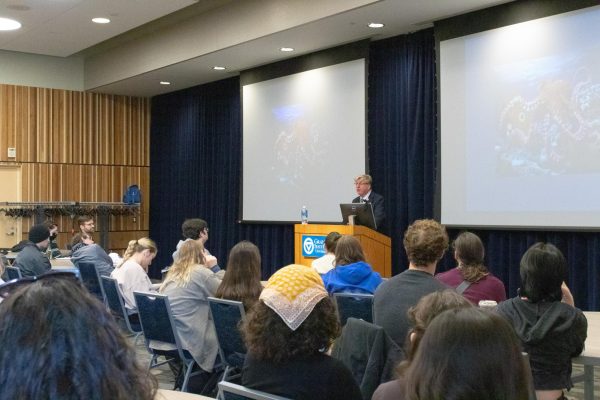Grand Valley State University recently welcomed a guest speaker from New York University (NYU) to present research about an ancient artifact that created waves in cinema and media.
Alexander Jones, Ph.D., the Leon Levy Director and Professor of History of the Exact Sciences in Antiquity at New York University, gave the keynote presentation on April 5 in the Mary Idema Pew Library. The presentation explored Greek history, focusing on one ancient artifact in particular: the Antikythera Mechanism.
Jones examined not only the history of science, but also the history of human innovation and creativity within the presentation. Jones is one of the nation’s leading researchers of the Antikythera Mechanism, the real ancient artifact which inspired the device in the 2023 film “Indiana Jones and the Dial of Destiny.”
While the Antikythera Mechanism isn’t exactly a tool for time travel as depicted in the movie, it does provide a glimpse of the ancient human past.
The Antikythera Mechanism is a Greek analog computer that dates back to the 2nd century BCE. It was discovered in 1901 by sponge divers off the coast of the Greek island, Antikythera. It is widely accepted as the first device used to track cycles of the solar system. The outside control dial allowed the operator to fast-forward or rewind time to illustrate the future or past positioning of the planets.
Jones said the mechanism inspired a more fantastical storyline in the Indiana Jones movie.
“In the film, (the Antikythera Mechanism) is turned into something more fantasy-like that leads to time travel,” Jones said. “It can lead to a kind of ‘mental time travel’ in the sense that you can see what was going on in the sky 50 years ago, but it’s not actually taking you there.”
Despite its dramatized portrayal in popular culture, the artifact maintains its significance to modern understandings.

The Mechanism appeals largely to GVSU’s Department of Classics, which looks closely at Greek history, however there is crossover into other academic subjects as well. The device can offer insight to historians, astronomers, physicists and mathematicians alike.
The presentation encouraged this multidisciplinary approach. The event aimed to showcase that history is more than dates and events, but that it’s also important to understanding the evolution of human thought and technology.
English student Eliana Burgess was interested in attending the presentation by Jones when she learned about it in her Latin course.
“We tend to have this habit of kind of mythicizing the past and humans that came before us,” Burgess said. “We kind of interpret a lot of their math and science as being very mythical. It is science, and it’s what we came from.”
Beyond its educational applications, the artifact has served as a testament to advancements made in the 2nd century BCE.
The object indicates that the ancient world was significantly more advanced in their scientific understandings than what was previously accepted. Jones said how the Mechanism challenged this perspective.
“We’ve been able to get a focused idea about things (about technology) we would not know if we were depending only on books that were passed through the tradition of copying manuscripts in the middle ages,” Jones said.
He described the discovery of the device as “accidental archaeology,” which has provided an entirely different picture of things that were happening over 2,000 years ago.
The recovery of any additional fragments of the Mechanism is unlikely. According to Jones, researchers have uncovered all there is to learn about the computational device with the resources available at the present. The remains of the Antikythera Mechanism are now on display at the National Archaeological Museum in Athens, Greece.
This ancient artifact serves a reminder that exploration has roots that stretch back centuries, and ancient technology continues to have relevance in the modern scientific environment.























